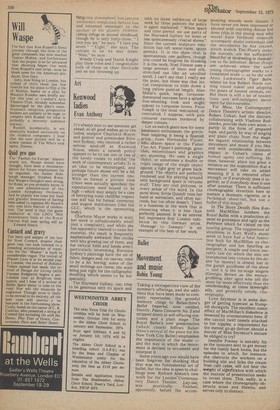Ballet
Movement and music
Robin Young
Taking a retrospective view of the summer's offerings, and the additions that have been made to company repertories, the grateful memory clings to Balanchine's Ballet Imperial, now retitled, bluntly, Piano Concerto No. 2 and stripped down to self-effacing costumes and a plain stage. The Royal Ballet's new presentation (which closely follows BalanL chine's revival of the piece for the New York City Ballet) emphasises the importance of the music — and the way in which the movement is devised to ornament and interpret it, Some years ago you would have been forgiven for thinking that that was the fundamental art of ballet, but the idea is open to chal. lenge now. Richard Alston's new work -for 'theLondon-Contemporary Dance Theatre, Lay-out, was practically finished, apparently, before the accom panying sounds were chosen. I have never yet been impressed or pleased with anything Alston has done (this is the young man who would have furniture removals accompany piano concertos) and the movements he has created, which stretch The Place's versatile dancers, are not sufficiently beautiful or interesting in themselves to fix attention. Better things are achieved when the same young choreographer works to a completed score — as he did with Anna Lockwood's Tiger Balm, where he has Robert North running round naked and adopting the poses of hunted animals, etc. But there is still a lot of tendentious and self-indulgent movement for the ensemble.
For Mass, the Contemporary Dance Theatre's artistic director, Robert Cohan, had the dancers, collaborating with Vladimir Rodzianko, provide their own score — partly in the form of prepared tape, and partly by way of singing and plain chant from the stage. An organic relationship between movement and music if you like, and with considerable dramatic impact in Cohan's vision of human agony and suffering. He does, however, place too great a reliance on the supposition that a movement will take on added meaning if it is repeated often enough, or if everybody does it together, or if everybody does it one after another. There is sufficient choreographic invention here to sustain a dramatic vignette, or a Peckinpah shoot-out, but not a ballet of this length.
In The Seven Deadly Sins Kenneth MacMillan lumbers the Royal Ballet with a production almost as grotesque and ugly as the Poltroon which he visited on the touring group. The suggestions of sleaziness in Kurt Weill's music seem to have had a fatal fasinalion both for MacMillan as choreographer and Ian Spurling as designer. A simple and ironic morality tale (in which the sins are transmuted into virtues by the desire for money) is almost lost in the garish gaudiness of the show — and it is the on-stage singers (Georgia Brown as the moneygrubbing alter ago) who tell the story far more effectively than the unconvincing, at times downright silly, and generally untidy, choreography.
Lynn Seymour is in some danger of getting typecast as frumpish showgirls. The excellent comic effect of MacMillan's Sideshow is lessened by overstatement here. If she cannot twirl tassels attached to her nipples, a requirement for the merest go-go dancer, should a dancer of Miss Seymour's stature be obliged to try?
Jennifer Penney is suitably fey as the innocent sent to get money for the family back home, but the episodes in which, for instance, she obstructs the workers on a building site and licks the cream from cafe cakes, will not bear the -*eight of slighfficance with whichthe manner of presentation seeks to invest them. This, sadly, is a case where the choreography obstructs score and libretto, and serves only to distract.
































 Previous page
Previous page